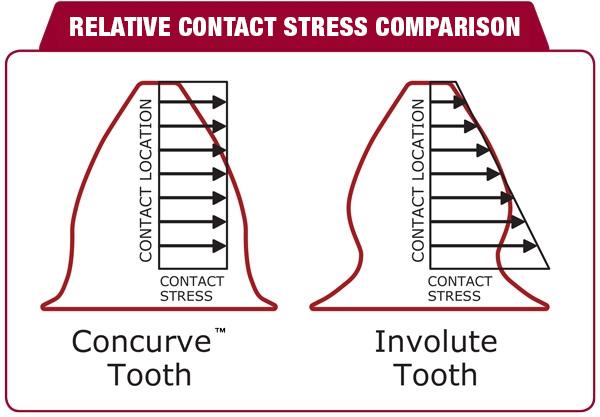
Concurve
The Concurve™ tooth form was developed to utilize the advantages and economies of other spur and helical forms while eliminating many of the design limitations normally encountered by gear engineers.
Particularly useful is a comparison between the Concurve tooth form and the conventional Involute tooth form. Concurve and Involute gear teeth, though often similar in appearance (most of the terminology is also the same), differ in some major respects. In fact, Concurve gearing offers many improvements compared to the involute profile.
The teeth on a set of Concurve™ gears are designed such that their relative curvature is practically constant at all points of tooth contact. As a result, the contact stress remains essentially the same throughout the zone of contact.
By contrast, one of the negative characteristics of the Involute form is the rapidly diminishing radius of curvature of the Involute curve in the vicinity of the base circle. At the base circle the radius of curvature of the Involute curve becomes zero. The contact stresses (Hertz stresses) between gear teeth become larger as the radii of curvature become smaller. Hence, Involute gears should not be designed for contact at or near the base circle.
Design modifications can often reduce this drawback of the Involute geometry, however, wide variations in contact stress along the active profile still remain. High contact stress below the pitch line puts a serious limitation on torque capacity.
The Concurve generating tool is designed such that it will not “undercut,” even when machining gears with very low numbers of teeth, down to as few as four.
Again, in contrast, one of the largest restraints in designing Involute gearing is the limitation on the minimum number of teeth due to the tendency of the generating tool to undercut or generate away the tooth profile in the region below the base circle. This obviously decreases the tooth bending strength considerably.
For example, AGMA recommends a minimum of 18 teeth for standard Involute forms of 20-degree pressure angle.
Apart from these improvements, Concurve gearing has retained all the advantages of standard gearing such as:
- Simplicity of conventional cutting tools. The Concurve generating tool with its curved profile is easily produced with present day toolmaking techniques.
- Relative insensitivity to errors in mounting center distance. Conjugate action remains essentially correct with normal variations in center distance.
- Production on conventional machines and in conventional ways such as hobbing, grinding, shaping and powder metal or plastic molding.
Because of these improvements, the Concurve gearing development has removed many of the constraints that have long been troublesome to gear designers. In design situations where low numbers of teeth (on one or both members of a gear set) would be desirable, Concurve gearing now offers the best solution.
Summarizing – the major inherent features in Concurve gearing are:
- Lower contact stress in the critical area below the pinion pitch line (due to constant relative tooth curvature).
- Lower tooth bending stress as a result of no undercut.
- Fewer gear teeth. Even a pair of 5-tooth pinions is possible.
These basic benefits can become physical and economic advantages such as:
- Higher torque/horsepower capacity from the same size gear set
- Higher ratios in a single gear set, 20:1 and higher
- Size and weight reduction due to fewer and smaller parts
- Increased wear and scoring resistance which results in increased life
- Higher reliability as a result of fewer parts and higher capacity
Do you have questions or need additional information? Contact us with the form link below or call 320-762-7133
